Having a problem with WordPress changes not showing on your site? This is a widespread issue for WordPress users. In almost all cases, the issue stems from caching problems, either in your own web browser, your WordPress site’s cache, or your content delivery network’s cache (CDN).
In this post, we’ll dig into what those reasons are and why caching can cause problems with WordPress changes not showing. Then, we’ll show you several troubleshooting steps to figure out the problem and make it so that you and your site’s visitors can see your site’s updates.
Ready? Let’s get started!
Prefer to watch the video version?
How Long Does It Take for WordPress to Update Changes?
Generally speaking, your WordPress site should update immediately after you hit the save button. That is, you should be able to hit the save button, open the page in question, and instantly see those changes. More importantly, the same should also apply to your site’s visitors.
That’s what should happen.
But since you’re reading this post, you’ve probably figured out that things don’t always go according to plan.
So what are some reasons why your site isn’t updating?
Why Is My WordPress Site Not Updating?
As we mentioned in the introduction, your WordPress site’s most common cause for not updating is caching issues.
There are different types of caching that might be preventing you from seeing changes on your WordPress site:
- Browser caching – stores certain static files on visitors’ local computers in the web browser cache.
- Page caching – stores the static HTML version of your site rather than using PHP to generate it “on the fly” for each visit.
- CDN caching – speeds up global load times by caching your site’s static content on a network of servers around the world.
You don’t have to understand the mechanisms behind caching now. The basic problem is that an earlier version of your site is still saved in the “cache.”
So, even though you’ve updated the version on your WordPress server, visitors (and you) might still be seeing the older and cached version of your site, hiding the changes that you pushed live recently.
We’ll spend most of the article showing you how to clear these various caches and “reload” them with the most recent version of your site. Once you purge the cache, you and your visitors should see the changes right away.
Beyond caching issues, another reason why you might not see changes on your WordPress site might have to do with permissions on your site. This is especially common if you’re creating dynamic sites where different users see different content, like in a membership site.
In this scenario, even if changes might be successfully saved, you might not have permission to see the updated content, and it might cause you to see the older content still. This is unlikely to cause the problem on simple sites such as blogs or portfolios, but it could be an issue with dynamic sites.
With that out of the way, let’s get into how to fix the problem.
How to Fix WordPress Site Not Updating Issues
We’ll divide these troubleshooting steps into four main sections:
For the first three, we recommend working through them from top to bottom. That is, start with clearing your browser cache and then move onto the others in order.
How to Fix Problems With Browser Caching
Browser caching works by storing certain site assets in your computer’s browser cache. It avoids repeatedly downloading these assets directly from your WordPress site’s server. To fix the problem, you can force your browser to download the freshest versions of all files from your server instead of loading them from the cache.
Here are a few ways to accomplish that.
Hard Refresh Your Web Browser
The simplest solution to fix browser caching issues on a single page is to hard-refresh your web browser.
When you force a hard refresh, your browser will skip the cache and download all web server assets.
To begin, open a tab with the page on your site where you expect to see changes. Then, hit the following keyboard combinations:
- CTRL + F5 on Windows
- Cmd + R on Mac
Clear Your Browser Cache
If the hard refresh didn’t work, you might need to clear your browser’s cache completely. This will wipe out all of the cached files, ensuring that you download new versions of all files across your site.
The exact instructions vary depending on which web browser you’re using, so please make sure to check out our full guide on how to clear the browser cache in all major web browsers.
Employ “Cache-Busting” Techniques
The above tactics should fix the problem for your own computer, but your visitors still might not see the changes right away (because they didn’t clear their browser caches).
One slightly more advanced tactic to get around this and make sure your visitors always see the latest version is to use a “cache-busting” tactic.
For example, let’s say your site’s logo is logo.png. If you update your logo and upload a new file with an identical name (logo.png), that change might not show up right away because people’s browsers will still load the original logo.png file from their cache.
To fix this with cache busting, all you need to do is change the filename.
For example, instead of uploading logo.png and overriding the old file, you could upload logo-v2.png. Because it’s a new filename, you’ll be able to bypass issues with your site’s changes not showing because of browser caching.
This tactic can also be useful for scripts, such as CSS stylesheets. So if your CSS changes are not showing up in WordPress, this is one tactic that might be able to fix that.
Other cache-busting tactics include changing the file path or adding query strings in addition to changing the filename. Some examples:
- Original: yoursite.com/style.css
- Filename – yoursite.com/stylev2.css
- File path – yoursite.com/v2/style.css
- Query strings – yoursite.com/style.css?ver=2
How to Fix Problems With WordPress Caching
While there are different types of WordPress caching, the most likely culprit is page caching.
Normally, your server “builds” your site’s finished HTML from scratch for each visit using PHP. Then, your server sends off the finished HTML to a visitor’s browser to render your webpage.
To speed things up, page caching lets you store the finished HTML in the cache, eliminating the need for your server to process the PHP and query the database on every visit. This means that if you update something on your site, that change won’t be available right away because your server is still serving the cached HTML from before you made the change.
Most web hosts and caching plugins get around this by automatically “clearing” the cache whenever you publish or update a piece of content. However, your caching solution might not be configured to do this, or it might just be not working properly for some reason.
Many caching solutions also exclude WordPress admin users from seeing cached content. This is why you might run into a problem with WordPress changes not showing up when logged out. In other words, when you’re logged into your admin account, you don’t see any cached content, which means you can see the changes right away. But when you log out, you’re seeing the older cached version (as are all your site’s visitors).
The fix here is to clear your site’s cache manually.
This will flush out all the stored HTML versions of your pages and have your site create a new version from scratch. It will then store that new version in the cache to get all the caching’s performance benefits.
How you clear your WordPress cache depends on what caching solution you’re using. We’ll show you two solutions:
- Clearing the cache if you’re hosting at Kinsta
- Clearing the cache in some popular caching plugins
How to Clear Cache as Kinsta Customers
Kinsta implements page caching for you so that you don’t need to use a WordPress caching plugin. There are two ways to clear your site’s cache at Kinsta.
First, you can do it from your WordPress site’s dashboard via the Kinsta Cache tab in the left sidebar and the Clear cache button:
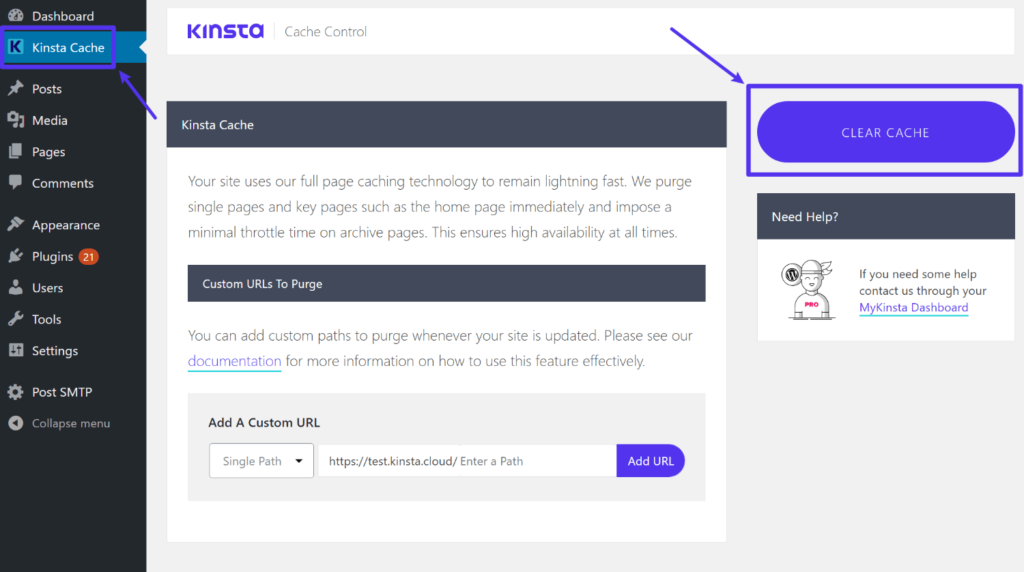
Second, you can also clear your site’s cache via your MyKinsta dashboard. Open your site in MyKinsta. Then, go to the Tools tab and click the Clear cache button under Site cache:

How to Clear Cache in Plugins
If you’re not hosting at Kinsta, you might be using a WordPress caching plugin to handle page caching.
All caching plugins include options to clear your site’s entire cache (and sometimes just the cache for individual pieces of content where you’re having issues).
We can’t show you how it works in all caching plugins, but we will show you some of the most popular plugins. Most caching plugins behave similarly so that you can use the same idea in other plugins.
WP Super Cache
You can click the Delete Cache option on the WordPress toolbar or in the plugin’s settings:

WP Fastest Cache
To delete the entire cache, you can click the Delete Cache option on the WordPress toolbar.
You can also only clear the cache for the piece of content that you’re experiencing issues with:
- Open the post/page/custom post type list.
- Hover over the piece of content that’s not showing changes.
- Click the Clear Cache link.
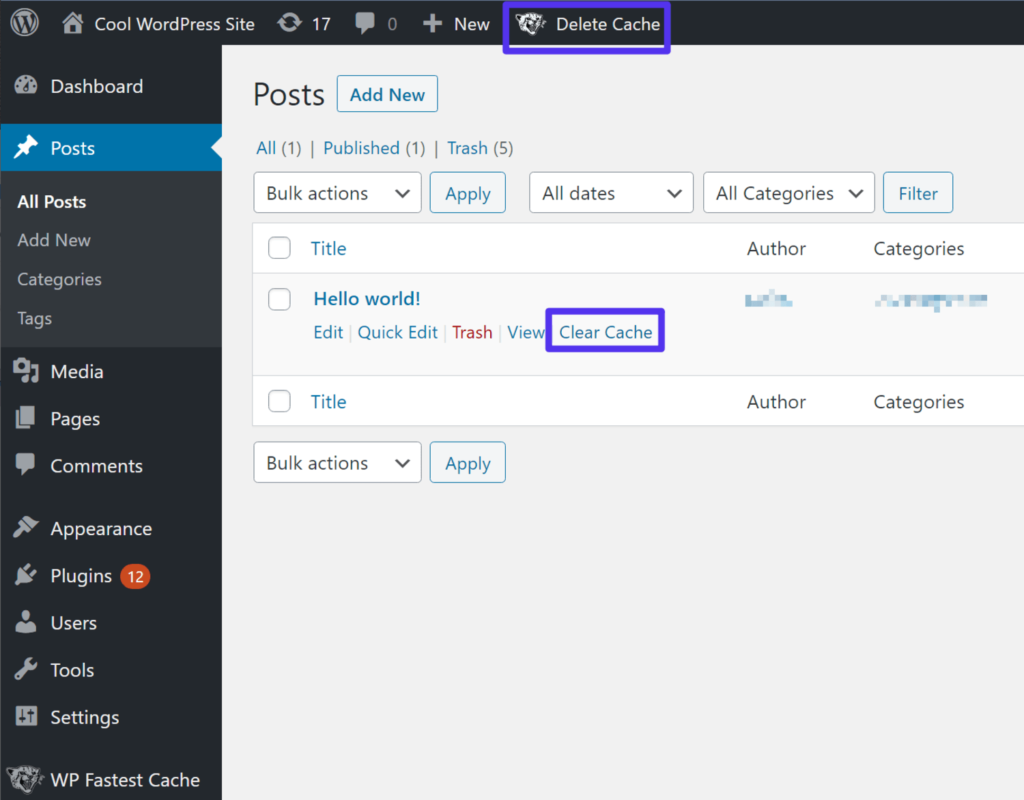
WP Rocket
To clear your entire site’s cache, hover over the WP Rocket option in the WordPress toolbar and select Clear cache:
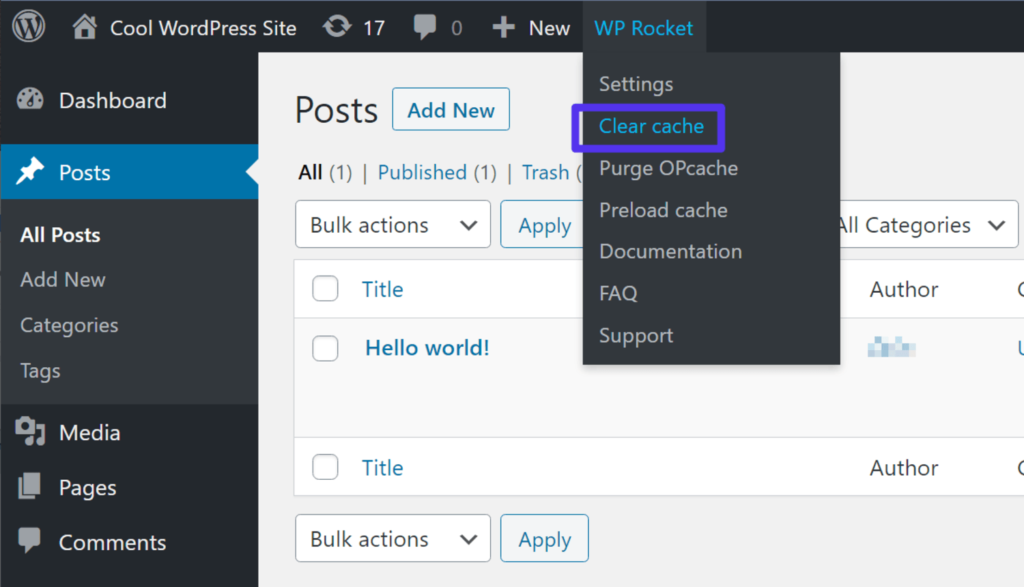
To clear a single piece of content, hover over it in the content list, and click Clear this cache:
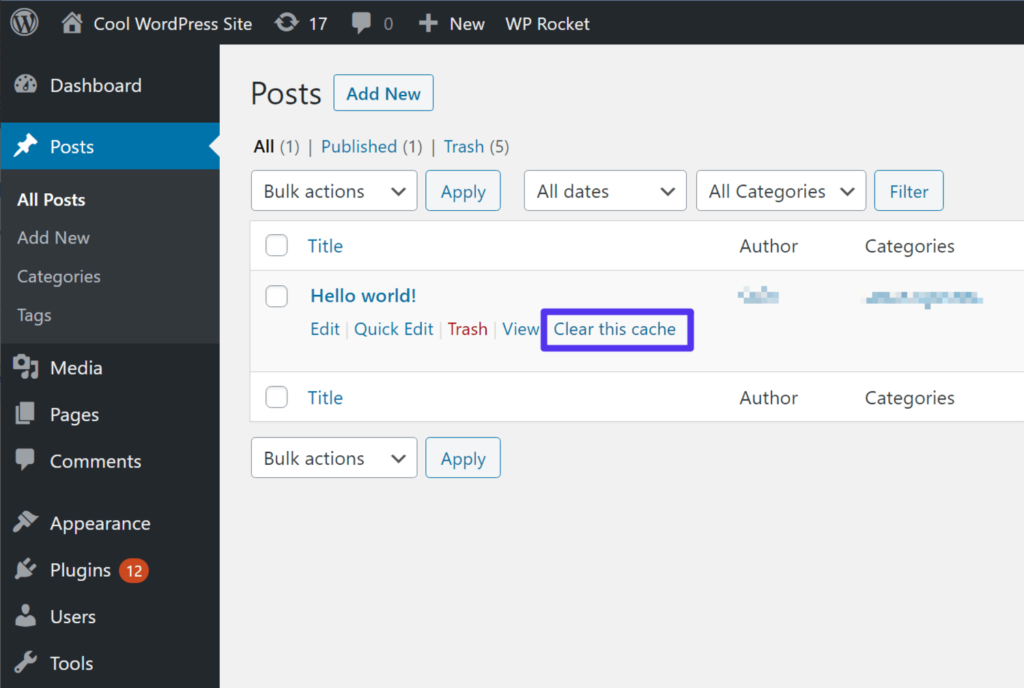
How to Fix Problems With CDN Caching
If you’re using a content delivery network (CDN) to speed up your WordPress site’s global load times, that could be another reason why your WordPress site’s changes aren’t showing.
A CDN works by caching your site’s static content on its network of servers around the world. Then, it serves up those files from the location that’s nearest to each visitor.
However, if your CDN has cached an old version of an image file or CSS stylesheet, that could lead to a problem with WordPress changes not showing. This is unlikely to happen with your content itself, but it can be a common problem with static files that you might be hosting on the CDN, such as images and scripts.
Recommended reading: WordPress Featured Image Not Showing Properly
As with the other caching problems, you can fix this by clearing the cache at your CDN. The exact steps to accomplish this will depend on your CDN. Here below, we’ll show you how to do that at Kinsta.
If you’re using a different CDN, you can consult your CDN’s documentation for help.
How to Clear Kinsta CDN Cache
Kinsta includes a built-in CDN at no extra cost. You can clear your CDN’s cache from your MyKinsta dashboard.
In MyKinsta, open the dashboard area for the WordPress site where you’re having issues. Then, go to the Kinsta CDN tab and click the Clear CDN cache button:
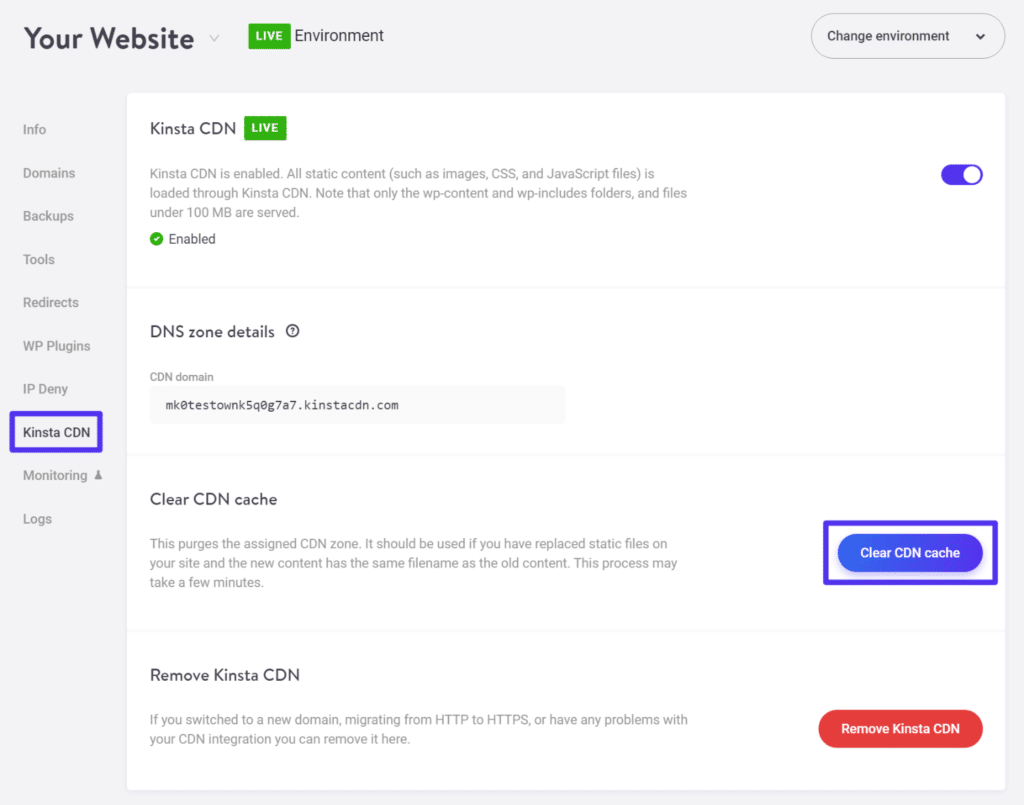
How to Fix Problem With User Roles/Capabilities
Finally, your site might be working totally fine, but you still might not see the changes you make because of some WordPress role/capability problem. Your site is updated correctly, but your user account doesn’t have permission to see the changes.
For example, maybe you have a membership site where registered members see one set of content, and anonymous visitors see different content. If you change the content for registered members and then open your site in Incognito mode, you won’t see those changes because your anonymous guest account doesn’t have permission to view the content you changed. And vice versa.
This can get even more complicated if you have a membership site with multiple different membership levels.
To fix this, make sure that you’re logged in to a WordPress account with the proper permissions to see the content in question (or that you’re not logged into an account, in some situations).
To make it easy to debug these issues and quickly switch between different WordPress accounts, you can use the free User Switching plugin.
Summary
Most of the time, problems related to WordPress changes not showing on your site have to do with caching issues (browser caching, page caching, or CDN caching).
The fix is to clear the cache causing these issues, making sure both you and your visitors are seeing the most recent version of your site. If you’re not sure which cache is causing the issue, we recommend clearing them in the order that we showed you in this post: first browser cache, then page cache, and finally CDN cache.
In some cases, you also might experience issues with being unable to see changes because you don’t have permission to see that content. This is unlikely to happen on a simple blog or portfolio site, but it can happen on membership sites or other restricted content sites. Make sure you’re checking using an account with the proper privileges to rule out this issue.
Are you still having any problems with WordPress changes not showing? Ask us in the comments!


